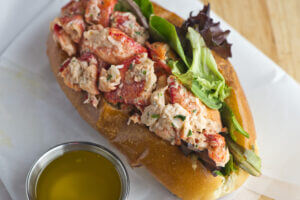
In the last twenty years or so, lobster rolls have skyrocketed in popularity nationwide. From food trucks to fine-dining to fast casual, this treat – closely associated with New England in the summertime – is quite pervasive. But how did the humble lobster roll, a favorite of those who leave off final “R”s with reckless abandon, become so popular, so quickly? You may think that scarfing down the sandwich in a fish shack down by the shore is a timeworn tradition in those parts, but these buttery, jam-packed rolls appear to be a more recent phenomenon. As Nutmeg-staters know, their story very likely begins a bit further to the south of Maine, along the Long Island Sound.
The Lobster Roll: Connecticut’s Contribution to American Cuisine?
We’re not going to talk about Maine just yet. The sandwich is surely most associated with our easternmost state (not counting a few of the Aleutian Islands of Alaska) in the minds of most, but the most popular origin story places it at a restaurant called Perry’s in Milford, CT in roughly 1929. According to Milford residents, and as written in the Encyclopedia of American Food & Drink:
“[the lobster roll] may well have originated at a restaurant named Perry’s in Milford, where owner Harry Perry concocted it for a regular customer named Ted Hales sometime in the 1920s. Furthermore, Perry’s was said to have a sign from 1927 to 1977 reading, `Home of the Famous Lobster Roll.’ “
While this assertion is often furiously rebutted by Mainers, Connecticut does boast its own version of the lobster roll that is distinct from the perhaps more famous cold, Maine-style roll. Piled high with piping-hot lobster claw and knuckle meat, the Connecticut roll features little more seasoning than the requisite gobs of melted butter and is served in the flat-top bun that New England is famous for.
Maine rolls instead feature a generous chilled lobster salad filling using knuckle and claw meat, just as their southerly cousin does. Mainers steam the lobster and dress it with mayonnaise, finely-chopped celery, a dash of lemon juice, and a healthy amount of salt & pepper. Beginning with a tourism boom in the 1950s and followed by the widespread proliferation of roadside lobster roll stands in the 1970s, the Maine roll, despite its shadowy origins, began slowly making its way across the country as the more well-known sandwich around the mid-to-late 20th century.
While we’ll decline to opine on where the lobster roll’s true origins lie, it’s likely that the first time someone ever put lobster between bread and ate it, they didn’t call it a “lobster roll”, put it on a menu, or otherwise take credit for it as a culinary creation. Lobsters were famously fed to prisoners in the nineteenth century because of their status as veritable pests and nuisances that cluttered up the beaches of the Northeast. It stands to reason that long before any identifiable restaurant or individual in a particular state could ”invent” the lobster roll, a fisherman or perhaps a prison guard, or ex-convict somewhere along the coastal northern Atlantic made something resembling a lobster roll as an easy and hearty dinner.
A Lobster Roll Gold Rush
Regardless of its exact origins, the lobster roll has exponentially increased in popularity since chef Rebecca Charles began offering her take on it at her restaurant (Pearl’s Oyster Bar) in New York City in 1997. Pearl’s was the first restaurant to serve Maine-style lobster rolls in Manhattan, and when it comes to dining trends, as goes New York, so goes the country. New York is also the publishing capital of America, and when a few magazine editors got wind of the buttery goodness going on at Pearl’s, the lobster roll quickly became a nationwide sensation. Soon, competitors such as Luke’s Lobster, Mary’s Fish Camp, and Ed’s Lobster Bar were popping up all over the city and expanding across the country. Other established restaurateurs began adding Maine-style lobster rolls to their menus and today, even fast-casual restaurants feature the rolls from Atlanta to Anchorage.
The good news is that you don’t need to be in New England or even go out to have an authentic lobster roll. With MyLiveLobster, you can have certified, authentic Maine lobster tails, or even live lobster packed in coolers and shipped straight to your door! Butter or mayo, hot or cold – we don’t judge! Just make sure you’ve got some nice hot dog buns to griddle, and you’ll have a fresh, exquisite taste of summer at the shore from the comfort of your own home. You’ll be ready for a dip in the ocean and a ”Sawx” game tout suite!

